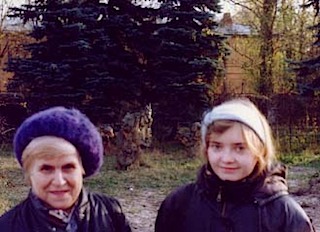The Global Thinking Project was created by a small group of American and Russian educators in 1989. Working together they created the first telecommunications network among American and Russian schools which consisted of five schools on each side. Chief among the Russian educators was Dr. Galina Manke (shown below on the left with a Russian GTP student from St. Petersburg), head of science at school 710, Moscow. She led the development of the translation of the GTP Teacher's Guide into Russian, and was responsible for providing GTP training to others schools and teachers in Russia.
The initial schools included:
American Schools Russian Schools
These ten schools launched the GTP, and for several years field tested the GTP's initial environmental curriculum. Through a series of annual project evaluations, the GTP staff revised and published newer versions of what was called the GTP Teacher's Guide. The Guide was used in a series of Summer Institutes which began in 1993. By that time schools from Australia, the Czech Republic, Singapore, Spain, other states in the US were involved. But the principal force in moving the GTP forward was the actions of many Russian teachers, school administrators, professors and scientists. One person, whose influence was central to the project's life was Mr. Vadim Zhudov, Director of Moscow Experimental Gymnasium 710. Vadim Zhudov, a recognized leader in the Russian educational community embraced the GTP by involving teachers and students in the project from its inception in 1989. To this day, the project is a a central theme in the school's curriculum. Indeed, School 710 was involved in more than 15 teacher exchanges, and seven secondary school student exchanges. A global relationship developed between School 710 and Dunwoody High School. Dunwoody High School was led by Dr. Jennie Springer, whose insight and research (hers was the first doctoral dissertation written using the GTP as a context for research entitled: A principal's perspective of the Global Thinking Project at Dunwoody High School: Implications for administrators, Unpublished doctoral dissertation, The Union Institute, Cincinnati, Ohio. USA) insured a ten year commitment to the project. She and Vadim Zhudov worked together for ten years using the GTP to foster teacher and student exchanges. In St. Petersburg, Gymnasium 157, along with other schools (Lyceum 1, School 91) and in concert with the Institute of Adult Education organized the activities of the Global Thinking Project. The project expanded to the towns of Puschino and Chelabinsk, as well as others. The Russian students posted many of their results on their own webpages. Many other Russian educators and citizens contributed to the success of the GTP. These included members of the Russian Academy of Education (Vasily Davidov, Anatoly Zaklebny (shown below), Simeon Vershlovsky, Galina Soukhopskya), researchers from Institutes in Moscow and St. Petersburg, teachers and administrators from the schools listed in the chart above. Some of the Russian schools have websites, and you might want to visit those that do to find out about these schools.


